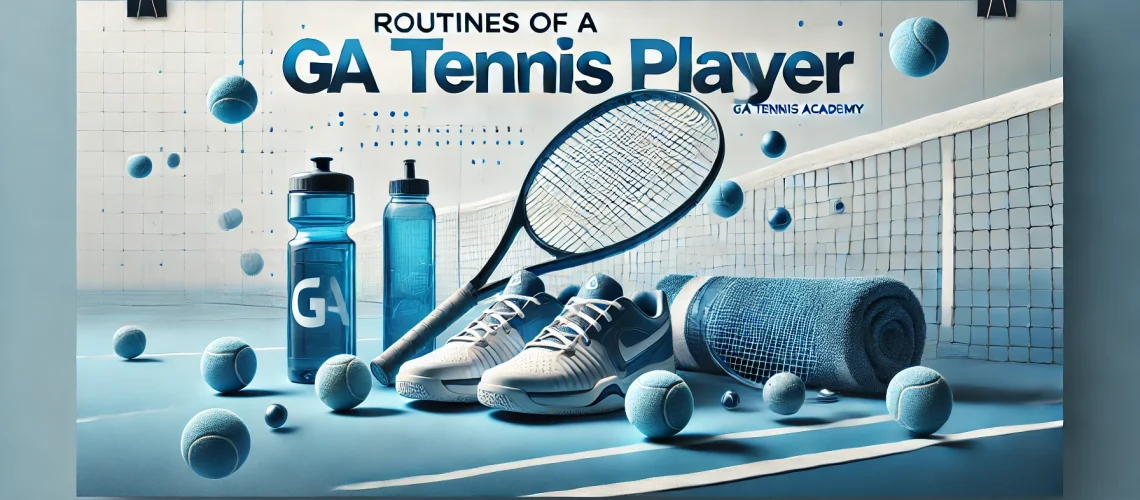When we think about what it takes to win in tennis, we often focus on the obvious factors—technique, tactics, and strategy. We observe these visible elements when professional players compete on the court. We study their shot mechanics, attempt to emulate their behaviors, and even analyze their gear. But what we see is just the tip of the iceberg. Beneath the surface lies a world of daily discipline and preparation that often goes unnoticed. What drives these athletes to consistently and relentlessly perform at such a high level? What habits and routines sustain their success?
Today, we will explore one of the most critical aspects of long-term improvement. These small, consistent actions, repeated over time, can create the foundation for exceptional performance. It’s often the most minor details, coupled with persistence, that can take you as far as your ambition allows. One of those critical details? Routines.
What Should You Take to the Tennis Court
Preparation begins before you even step on the court. Properly equipped ensures you’re mentally and physically ready to perform your best. Here’s a checklist of essential items to keep in mind:
- Rackets and Tennis Shoes: These are your indispensable tools. Your racket and shoes should be your top priority whether you’re heading to practice or a match. Always ensure your rackets are in top condition—check string tension, grips, and the number of rackets you carry. Equally important is ensuring you have the right shoes for the surface you’ll be playing on. Clay, hard, and grass courts all require different types of shoes to provide proper grip, support, and traction. Wearing the wrong shoes can affect your movement and even increase your risk of injury.
- Water: Staying hydrated is crucial. Bring plenty of water and know how to pace your intake throughout your time on the court.
- Isotonic Drinks: Sweat leads to a loss of essential salts and minerals. An isotonic drink will help replenish these and keep your energy levels stable.
- Snacks (Bananas, Energy Bars, etc.): Consider your tennis session a marathon, not a sprint. Bring snacks like bananas or energy bars to fuel your body throughout the day.
- Towel: A towel is more than just a way to wipe off sweat. It can serve as a brief mental break between points, a moment to collect your thoughts and refocus.
- Change of Shirt: After an intense session, your shirt might feel like it weighs a ton. Having a fresh one on hand will keep you comfortable and focused.
- Spare Laces: A broken shoelace in the middle of a match is more than just an inconvenience—it can disrupt your momentum. Always carry an extra pair.
- Adhesive Plaster: Even if you can tolerate minor pain, it’s wise to eliminate distractions like blisters. A simple plaster can prevent discomfort from becoming a more significant issue.
- Cap and Wristbands: Depending on the weather or your preference, a cap and wristband can be essential, helping manage sweat and providing protection from the sun.
- Notes: Writing down your thoughts, strategies, or reflections can be powerful. Keep a small notebook to jot down anything you’d like to remember or work on during your next session.
How to Arrive at the Court: The Right Mindset
- Arrive Calm and On Time: Rushing onto the court can leave you feeling disorganized and flustered. Arriving with time to spare allows you to prepare and focus mentally. Take a moment to gather your thoughts before stepping onto the court.
- Warm-Up Properly: Even if you don’t have time for a warm-up session, go through at least a basic routine to prevent injury and activate your body. A proper warm-up primes both your body and mind for the work ahead.
- Have a Plan: Whether you’re playing a match or just practicing, it’s essential to approach the court with clear objectives. What are you focusing on today? What areas of your game need improvement? Having a plan will give structure to your time on the court.
- Stay Flexible: While having a plan is essential, adaptability is vital. The nature of tennis requires you to respond to ever-changing circumstances. Your opponent may push you to rethink your strategy mid-match. Be prepared to adjust your approach as needed.
- Create Routine Associations: Associating specific actions with routines can help you stay focused. For example, if you bounce the ball three times before serving, use that moment to remind yourself of a critical technical point—such as keeping your left arm extended during the serve. These small associations can keep you grounded, especially under pressure.
After the Match: The Importance of Recovery
- Jog to Release Stress: A light jog after a match helps release tension and initiates recovery, allowing your body to wind down gradually.
- Stretch: Stretching after your session is crucial to prevent muscle tightness and reduce the risk of injury. Remember to stretch after your jog, not in the shower.
- Shower and Change: This marks the end of your session and is also an essential step in recovery. Clean clothes and a refreshed body help shift your mindset towards rest and recovery.
- Rehydrate and Refuel: Proper hydration and nutrition are essential post-match. Replenishing lost fluids and eating the right foods accelerates recovery and prepares your body for future performance.
Building Professional Habits Through Routine
Incorporating these simple routines into your practice will help you establish professional habits that improve your performance. While you will eventually develop personal routines that suit your needs and style, starting with these foundational details will make you a more effective player.
With time and consistency, these small actions will significantly improve your game.
A Final Thought
Small details can lead to significant results. Sometimes, it’s the tiniest adjustments that create the most important impact. Don’t underestimate the power of consistent, well-thought-out routines. They are the backbone of success, both in tennis and in life.
By mastering these simple routines, you’re not just preparing for one match—you’re laying the foundation for long-term success in tennis. Whether you’re a weekend player or aspire to go pro, these habits can elevate your game and help you reach new heights.










